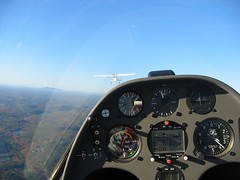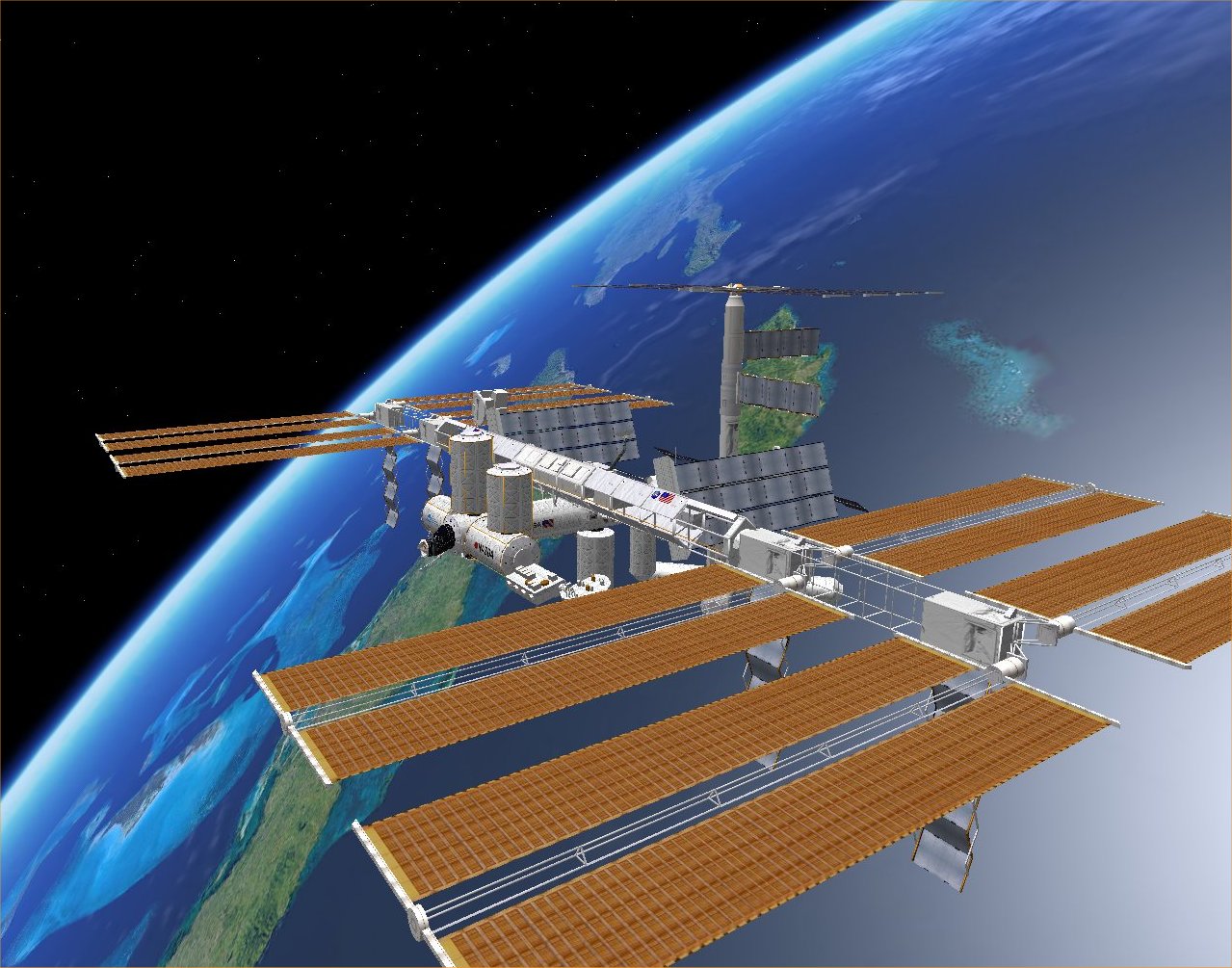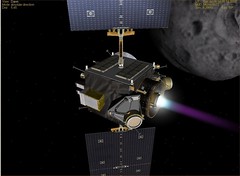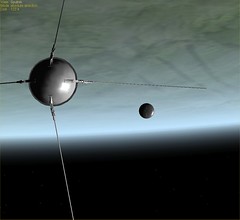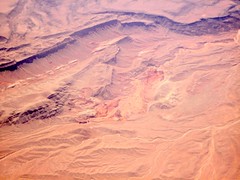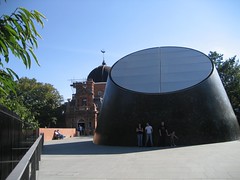
I’m in something of a blogging rut, which happens sometimes. Work and travel have been taking up a lot of time, and even with the help of
Bloglines (which is great), I’ve been having trouble keeping up with all the space and astronomy news and blogs that I might like to comment on. Plus I have to admit that having a new iPod is also pretty distracting. I’m embarrassed to find myself doing marginally crucial things like creating new playlists and making sure I have album cover artwork for most of the songs (this is mainly so they look cool in the new Cover Flow view). Can something be lame and cool at the same time? Yes.
I haven’t done a “what’s it all about” post for a while, and I just found a note to myself reminding me of an interesting conversation I had on a Boston-LAX flight back in August. My seat mate was a retired science and art teacher who was also a Vietnam vet. He even had a Mercury-era space connection. I wish I had written about this sooner or at least took some notes, because he had a lot of great things to say. But let’s see where it goes anyway.
I was reading a space-related book, and he asked me something about it. This led to me mentioning that I was doing educational outreach using space and astronomy themes as a JPL Solar System Ambassador. He mentioned that he had been a science teacher in public schools (Los Angeles area) for a number of years, and he had even hosted an after-school science TV program for a couple of years. He later switched to teaching art (he’s also an artist). We also spent a lot of time discussing Vietnam and the sixties – he had served in the Army in the unit that is featured in the book and movie
We Were Soldiers Once… and Young (1st Cavalry, 7th Battalion, 1965), a fascinating discussion in itself. But I want to talk about the science education stuff.
We talked about what really happens in classrooms, about “stars” and regular students, about motivation, about why kids are not that interested in science and math, about the role of money and our society’s cues about what’s important and valued. It’s messy and more than a little discouraging.
I told him about my experience with a math teacher at my tiny high school in 1968-69, the guy who took a special interest in me and helped me get some computer experience that led to me getting into a good school so I could study computer science and eventually physics and optics (I ended up working for most of my career with software for optics and other things). He said I was obviously a “star” student – he also had a few of those, some of whom still keep in touch with him after many years. He said the stars are easy – it’s the regular kids you worry about. And the teachers.
He said that many teachers just don’t have the training, ability, or inclination to really teach science well. If they’re not very knowledgeable or excited about it themselves, it’s hard for them to inspire and engage the students. Of course this isn’t a big revelation, but his point was that the “stars” will find a way to progress in spite of poor teachers, as I did with my outside reading and activities like Civil Air Patrol when I was in school. Most of the other kids will muddle through (if that) and conclude that science is boring, useless, and irrelevant.
Another thing we discussed is the way that kids today are obsessed with money, material goods, and status. Of course media and marketing provide a steady stream of messages reinforcing the idea that money and status are firmly linked and highly desirable, and defining the cool and fast ways to get money and status. Needless to say, science, math, and engineering are not on the fast track to coolness among kids of today.
Finally there is the idea that school is about knowing the answers to sets of specific questions (an idea that is reinforced by the standardized tests that define success in today’s schools – success for school administrators and teachers if not for the students themselves). Science comes across as rather annoying when you often have to say “do the math, do the experiment, figure it out” rather saying “the answer is D.” Science is like life - messy, but potentially very satisfying.
So how does this affect me as an informal educator? I’m trying to provide some sort of enrichment activities that engage students and perhaps get them to think that at least some of this science stuff is cool and is worth the effort to do the math or the experiments or observations, to stick with work that can be genuinely hard and sometimes frustrating, but to sometimes experience the thrill of mastering something whose answer is not A, B, C, D, or none of the above.
But it sounds like when I talk about stars, it’s the “stars” I am most likely to reach with my message, the few kids who already have more unusual interests, who are already interested in science, math, and technology. The others will either not get it or not bother to show up if it’s an optional event. I guess I had already calibrated that in my plans – not that I’m giving up on anyone, but I have said many times that if even one or a few kids end up getting interested in science, math, or technology in part as a result of my space cadet activities, it will have been worth it.
But another question is, how did the “stars” get that way? Something inspired them, made them different (and willing to be different, which I can attest is sometimes not the greatest thing to be). What was it? Probably their parents and their home environment (and genes) for starters. Reading and adult-level conversation from an early age were important for me, and then somewhere around age 9 I caught the space bug (I think it started with John Glenn’s
Friendship 7 Mercury orbital flight in February 1962, and especially the photo stories in LIFE magazine, supplemented by “NASA Facts” and posters that I soon started writing to request).
I don’t remember any educational outreach people from my early childhood who influenced me, and aside from Mr. Call in high school, I don’t remember any teachers who specifically encouraged my interest in science and math, though I’m sure I was praised for doing well in these subjects. There were some early museum trips (Museum of Natural History and Hayden Planetarium in NYC around age 7 is all I really remember). There were a lot of books. I especially remember the Random House “All-About” non-fiction book series for young readers, and I watched a lot of Disney science and nature specials, which my mother also enjoyed. There was a rock collection and later a chemistry set. The usual nerdy indicators.
I don’t know. Maybe I’m preaching to the converted in my outreach activities (not to mention this thing – who reads a “space blog” besides other space bloggers and space geeks, which I mean as a term of endearment, not scorn). But you never know. You just never know. And I apparently like to write and talk about and play with space stuff, so it’s not like it’s a hardship for me. But I would like to know how we can get more “stars” in our schools – can it happen without another Sputnik, JFK, or Apollo? I don’t know.
But finally back to the space connection for my interesting seat mate on the LA flight. He was a “body double” for spacesuit testing for one of the original Mercury 7 astronauts (I wish I took notes - I think it was Gordon Cooper). As a college student, he somehow heard of a part-time job which involved standing in for the astronauts at a company that was testing the original space Mercury spacesuits (I think it was AiResearch Manufacturing Division, Garrett Corporation, Los Angeles). They took a lot of detailed body measurements, and it turned out that his body dimensions were a perfect match for one of the seven, so he was the stand in for various tests on the suits made for “his” astronaut. He never met any of the astronauts, but it was a pretty interesting and unusual part-time job for a college student and future science teacher!
Sometimes it's cool to talk to the person next to you on a flight. Fortunately I had not yet replaced my iPod at that point!
 I haven't seen it myself yet, but Comet 17P/Holmes has gotten bright enough to see with the unaided eye, and I'm hoping we can see it through telescopes at a Saturday night star party that Aldrich Astronomical Society is doing with a scouting group.
I haven't seen it myself yet, but Comet 17P/Holmes has gotten bright enough to see with the unaided eye, and I'm hoping we can see it through telescopes at a Saturday night star party that Aldrich Astronomical Society is doing with a scouting group.





